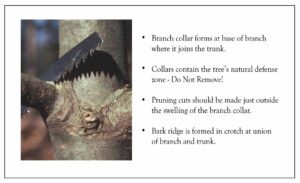Leaflet: Prepare Your Trees For Winter

Pruning techniques to make your trees more resilient to winter storms
The temperatures have dropped, and it’s probably just a matter of time before we get some serious winter weather. The best thing we can be doing this time of year to make our trees more storm resilient is pruning. We’re going to walk you through the pruning techniques that will help a tree if and when we get another serious winter storm.
As we’ve seen more and more in recent winters, the combination of wind and ice will lead to branch failure—in short, nature prunes itself. That’s exactly why it’s best to prune problem areas now rather than waiting until snow and ice is predicted. Ice can increase the weight load on a branch by up to 30 times.
For an even more in-depth guide to pruning, visit our pruning page.
Prune outside the branch collar. The most important technique when pruning any branch, whether it’s a quarter-inch or four inches diameter, is to prune just outside the branch collar. On some types of tree, the branch collar is obvious. It is that bit of swelling—like a collar—at the base of where the branch connects to the trunk. That swelling is an accumulation of healing hormones. If you cut flush against the trunk, you’re cutting away the hormones that will close it off and protect it from pests and diseases.

Remove the Ds. The best way to start is to look for branches that are dead, diseased, dying, or decaying— anything that starts with a D. Just take a nice pruning saw or or some hand pruners and prune that right out of the tree.
A small six- or seven-inch folding saw is really all that a homeowner needs. We could do 99% of what we end up doing with just hand pruners and a folding saw on a young tree.
Mind your pruning budget. You shouldn’t prune away more than 25% of your tree’s canopy. Leaves are effectively solar panels that produce energy for the tree, and you don’t want to remove too much of that. Sometimes people want to prune their trees to encourage it to grow taller, and they’ll prune all the lower branches and make a sort of lollipop. So another part of calculation is that two-thirds of the trunk needs to have lateral branches.
Dead and dying branches do not count toward that budget, because they are not producing energy for the tree. The tree wants to lose those anyway and, as we already mentioned, nature will more recklessly prune them away during the next storm if you don’t. Suckers—the small branches at the base of the trees—should also be removed. While they do have leaves, they also do not count toward that budget, because they could become so vigorous that they just take over.
Look for included bark. A wide angle between a lateral branch and the trunk creates better architecture than a sharper angle. When the angle is more acute, the bark will start to fold over itself in the crease at the connection point. This is called included bark. Branches with included bark are where more than 80% of failures happen.

There might be instances where pruning all the branches with included bark will take you beyond your pruning budget, in trees like Japanese maples, zelkova trees, or columnar (upright) cultivated varieties. There are ways to address included branches without removing them entirely. You can cut away the most vigorous upright branches along the branch, which will stop that branch from growing more. There is a gravity-fed hormone in upright branches that encourages growth. By removing the upright branches, you change the hormones to those for repair and reproduction and in doing so, slow the growth of the branch relative to the trunk.
Encourage a strong central trunk. We’re trying to prune trees to have a strong central trunk—or central leader. Some trees, like conifers, grow a central trunk naturally. Other trees want to have a more rounded canopy. We want to create a strong backbone so that a tree is more resilient to wind. It is a bit unnatural, but when we are planting trees in the built environment, we have safety considerations to keep in mind. If a tree is in the middle of a giant backyard, it can take a more natural shape, but if it’s somewhere where its branches could fall on a house or a car, it’s helpful to have that strong central trunk.
When you prune, look for a strong central leader on a young tree that can be encouraged as it matures, and prune away competitive side branches. The rule of thumb is that you don’t want to have any lateral branches that are more than half the diameter of the central leader. By keeping those side branches smaller, if they fail, it’s less likely to be catastrophic to the tree or its surroundings.
If a storm comes!
When a winter storm does arrive, what do you do? Shake off snow, but not ice. Light snow can be gently shaken from branches with a broom moved in an upward motion. Heavier snow and ice should be allowed to completely melt because branches with ice especially often fail when shaken.
Once the snow is gone, inspect your tree for damage, taking care to take safety precautions as necessary. You can use a pruning saw to cut away any dead or damaged branches at the nearest branch collar.
Pruning resources:
- We have an entire webpage on how to prune that gets into even deeper detail.
- If you have a bigger tree, and the task of pruning it is beyond you, get in touch with one of these recommended arborists.
- If you have a specific question that you just can’t crack, you can write our new email address for pruning questions: [email protected].
